Aug 17, 2022
Norway to Raise Rates to Highest in a Decade: Decision Guide
, Bloomberg News

(Bloomberg) -- Norway is poised to raise borrowing costs to the most in over a decade as unexpectedly rapid inflation challenges earlier plans for more gradual increases.
The central bank will lift its key policy rate on Thursday by a half-point to 1.75%, according to most economists surveyed by Bloomberg. That would be the highest since March 2012, with investors watching for hints of a matching move in September that markets are already pricing in.
A 50 basis-point hike would align the Norges Bank more closely with the aggressive steps taken by the world’s top monetary authorities to tackle soaring inflation. It also indicates heightened urgency: After raising by a half-point in June, policy makers had voiced a preference for quarter-point increases for the rest of 2022.
“We feel quite confident they’ll do 50 basis points rather than 25,” Swedbank economist Marlene Skjellet Granerud said, pointing to recent price and jobs data. “The top priority will be to fight inflation, which came in markedly above expectations in July. And when you have lower-than-anticipated unemployment on top of that, then 50 basis points should be quite certain.”
Norway was among the first rich-world nations to start raising borrowing costs last year after weathering the pandemic better than most. Inflation, however, has hit its highest level in 34 years, with an underlying gauge topping central-bank projections since April. Jobs data, meanwhile, signal sustained price pressure, with unemployment at just 1.7%.
Thursday’s decision will come at a so-called interim meeting that won’t include an updated economic outlook or projections for the path of interest rates. It takes place with speculation building that neighboring Sweden will raise borrowing costs by 75 basis points next month -- mirroring the most recent move by the Federal Reserve.
In Norway, the outlook for housing and spending by households -- some of the world’s most indebted -- could still tilt policy makers toward a quarter-point hike, though a bigger step is more likely, according to DNB economist Oddmund Berg.
Debts of Norwegian households were equivalent to 241% of net disposable income last year -- second only to Denmark, OECD data show.
“One of the reasons for taking a gradual approach is the high debt-to-income ratio and extremely high share of floating interest-rate loans,” Berg said. “It doesn’t seem much of a factor now, but could very much become one. That being said, housing prices aren’t the only thing to look for here. I think the Norges Bank will be paying very close attention to household consumption.”
©2022 Bloomberg L.P.






